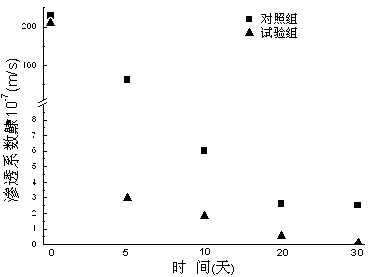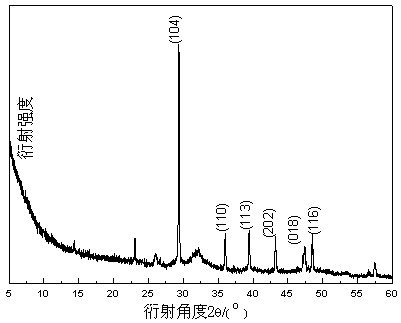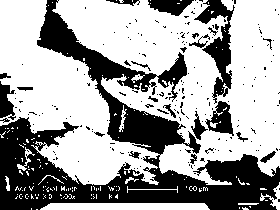Method for repairing crack of cement-based material
A technology of cement-based materials and cementitious materials, which is applied in the field of interdisciplinary science, can solve the problems that organic matter is not environmentally friendly and the repair effect is not ideal, and achieve fast carbonate deposition rate, slow down the greenhouse effect, and polycarbonate The effect of sedimentation
- Summary
- Abstract
- Description
- Claims
- Application Information
AI Technical Summary
Problems solved by technology
Method used
Image
Examples
Embodiment 1
[0044] (1) Weigh 12g of sucrose, Na 2 HPO 4 12H 2 O 3g, MgSO 4 0.6g, CaCO 3 1.5g, KCl 0.2g, (NH 4 ) 2 SO 4 Dissolve 0.6g and 0.4g of yeast extract in 1000mL deionized water, prepare the required medium solution, adjust the pH to 7, sterilize at 125°C for 25 minutes, take it out and wait for cooling, inoculate Bacillus colloidus to cooling culture In the basal solution, shake culture at 30°C, the shaking frequency is 170 r / min, and the culture time is 24h;
[0045] (2) Centrifuge the cultured bacterial solution at high speed for 10 minutes at a speed of 8000 rpm and a temperature of 4°C to remove nutrients from the upper layer of the culture medium and add 100 mL of deionized water to make a concentrated bacterial solution;
[0046] (3) Soak 200g of ceramsite in 100mL of Bacillus mucilaginous concentrated bacterial solution for 24h and set aside for use. The water-to-cement ratio of the cement-based material is W / C=0.36, the amount of cementitious material is 1300g, a...
Embodiment 2
[0050] (1) Weigh 9.6g of sucrose, Na 2 HPO 4 12H 2 O 2.4g, MgSO 4 0.48g, CaCO 3 1.2g, KCl 0.16g, (NH 4 ) 2 SO 4 Dissolve 0.48g and 0.32g of yeast extract in 800mL of deionized water, prepare the required medium solution, adjust the pH to 7, sterilize at 125°C for 25 minutes, take it out and wait for cooling, inoculate Bacillus colloidus to cooling culture In the basal solution, shake culture at 30°C, the shaking frequency is 170 r / min, and the culture time is 24h;
[0051] (2) Centrifuge the cultured bacterial solution at high speed for 10 minutes at a speed of 8,000 rpm and a temperature of 4°C to remove the nutrients in the upper medium, and add 80 mL of deionized water to make a concentrated bacterial solution;
[0052] (3) Soak 150g of ceramsite in 80mL of Bacillus mucilaginous concentrated bacterial solution for 24h and set aside. The water-to-cement ratio of the cement-based material is W / C=0.36, the amount of cementitious material is 1300g, and 40g of tetrahyd...
Embodiment 3
[0056] (1) Weigh 8g of sucrose, Na 2 HPO 4 12H 2 O 2g, MgSO 4 0.4g, CaCO 3 0.5g, KCl 0.1g, (NH 4 ) 2 SO 4 Dissolve 0.4g and 0.2g of yeast extract in 500mL deionized water, prepare the required medium solution, adjust the pH to 7, sterilize at 125°C for 25 minutes, take it out and wait for cooling, inoculate Bacillus colloidus to cooling culture In the basal solution, shake culture at 30°C, the shaking frequency is 170 r / min, and the culture time is 24h;
[0057] (2) Centrifuge the cultured bacterial solution at high speed for 10 minutes at a speed of 8,000 rpm and a temperature of 4°C to remove the nutrients in the upper layer of the culture medium, and add 50 mL of deionized water to make a concentrated bacterial solution;
[0058] (3) Soak 100g of ceramsite in 50mL of Bacillus mucilaginous concentrated bacterial solution for 24h and set aside. The water-to-cement ratio of the cement-based material is W / C=0.36, the amount of cementitious material is 1300g, and 65g p...
PUM
| Property | Measurement | Unit |
|---|---|---|
| particle diameter | aaaaa | aaaaa |
Abstract
Description
Claims
Application Information
 Login to View More
Login to View More - R&D
- Intellectual Property
- Life Sciences
- Materials
- Tech Scout
- Unparalleled Data Quality
- Higher Quality Content
- 60% Fewer Hallucinations
Browse by: Latest US Patents, China's latest patents, Technical Efficacy Thesaurus, Application Domain, Technology Topic, Popular Technical Reports.
© 2025 PatSnap. All rights reserved.Legal|Privacy policy|Modern Slavery Act Transparency Statement|Sitemap|About US| Contact US: help@patsnap.com



